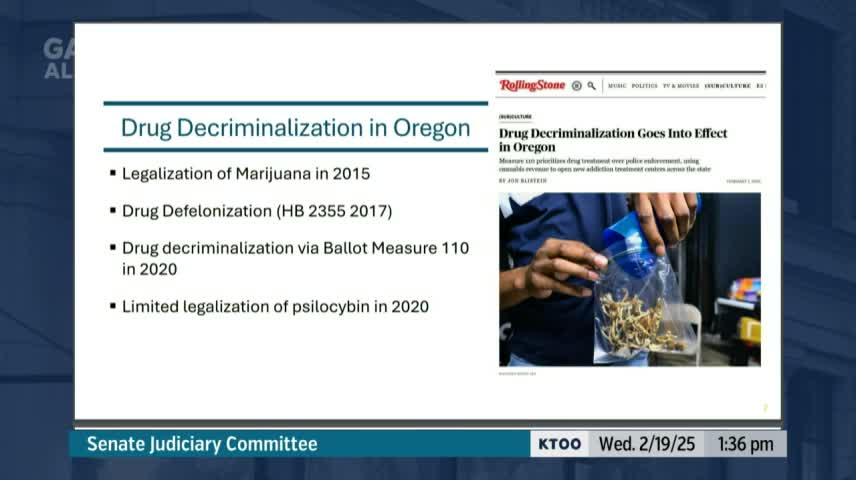Oregon implements drug defelonization and establishes addiction recovery centers with Measure 110
February 19, 2025 | 2025 Legislature Alaska, Alaska
This article was created by AI summarizing key points discussed. AI makes mistakes, so for full details and context, please refer to the video of the full meeting. Please report any errors so we can fix them. Report an error »

During a recent meeting of the Alaska Legislature's House Judiciary Committee, lawmakers discussed the implications of drug policy changes, particularly focusing on the historical context of drug defelonization and its impact on the community.
The conversation highlighted House Bill 2355, passed in 2017, which marked a significant shift in how drug possession was treated under the law. Prior to this legislation, possession of controlled substances was classified as a felony in most cases. However, HB 2355 introduced a new classification for "user quantities" of drugs, allowing individuals without prior felony or misdemeanor convictions for similar offenses to be charged with a misdemeanor instead. This change aimed to reduce the number of individuals facing felony charges for minor drug possession, ultimately leading to an 18% decrease in overall arrests for drug possession.
The committee noted that this shift not only reduced the number of first-time felons but also contributed to a decrease in racial disparities at the felony level, although these disparities persisted at the misdemeanor level. The discussion underscored the importance of these changes in helping individuals avoid the long-term consequences of a felony record, which can significantly impact their lives and opportunities.
Further developments in drug policy were also addressed, particularly the decriminalization efforts initiated by Ballot Measure 110 in 2020. This measure mandated the establishment of local addiction recovery centers and redirected marijuana tax revenue to support these initiatives. The committee acknowledged the challenges faced in implementing these changes, including delays in funding and infrastructure development for treatment programs.
As Alaska continues to navigate its drug policies, the discussions from this meeting reflect a broader commitment to addressing substance use issues in a way that prioritizes treatment and rehabilitation over punitive measures. The outcomes of these legislative efforts are expected to have lasting effects on the community, particularly in improving access to addiction recovery resources and reducing the stigma associated with drug possession.
The conversation highlighted House Bill 2355, passed in 2017, which marked a significant shift in how drug possession was treated under the law. Prior to this legislation, possession of controlled substances was classified as a felony in most cases. However, HB 2355 introduced a new classification for "user quantities" of drugs, allowing individuals without prior felony or misdemeanor convictions for similar offenses to be charged with a misdemeanor instead. This change aimed to reduce the number of individuals facing felony charges for minor drug possession, ultimately leading to an 18% decrease in overall arrests for drug possession.
The committee noted that this shift not only reduced the number of first-time felons but also contributed to a decrease in racial disparities at the felony level, although these disparities persisted at the misdemeanor level. The discussion underscored the importance of these changes in helping individuals avoid the long-term consequences of a felony record, which can significantly impact their lives and opportunities.
Further developments in drug policy were also addressed, particularly the decriminalization efforts initiated by Ballot Measure 110 in 2020. This measure mandated the establishment of local addiction recovery centers and redirected marijuana tax revenue to support these initiatives. The committee acknowledged the challenges faced in implementing these changes, including delays in funding and infrastructure development for treatment programs.
As Alaska continues to navigate its drug policies, the discussions from this meeting reflect a broader commitment to addressing substance use issues in a way that prioritizes treatment and rehabilitation over punitive measures. The outcomes of these legislative efforts are expected to have lasting effects on the community, particularly in improving access to addiction recovery resources and reducing the stigma associated with drug possession.
View full meeting
This article is based on a recent meeting—watch the full video and explore the complete transcript for deeper insights into the discussion.
View full meeting
